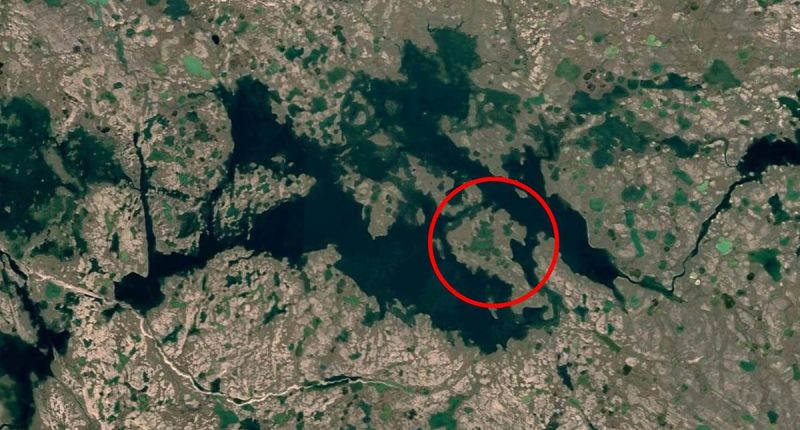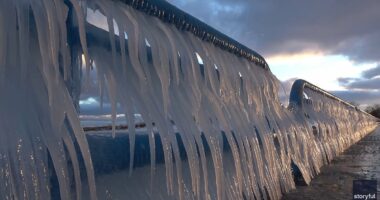Share this @internewscast.com
The remote regions of the world are full of some incredible and baffling mysteries.
Now, one discovery, shared in a viral post on Instagram by @mindset.therapy, has left social media users reeling.
Located in remote northern Canada, this is the world’s largest island-in-a-lake-on-an-island-in-a-lake-on-an-island.
If that description sounds confusing then you’re not alone, as Instagram users have flocked to the comments to complain that the island left them with a ‘headache’.
One frustrated user vented: ‘That just scrambled my brains.’
At the centre of this geological Russian nesting doll is a small, sea-horse-shaped island measuring just over 300 metres (1,000ft) long from end to end.
That island is nestled inside a small unnamed lake which takes up most of the area of another larger island.
This, in turn, is sat within a 55-mile (90km) lake located near the coast of Victoria Island, the eighth largest island in the world.

Social media users have been baffled to discover the largest island-in-a-lake-on-an-island-in-a-lake-on-an-island. Pictured: The unnamed 300-metre (1,000ft) long island on the lake on an island

Zooming out, you can see that this island is sat inside a larger, 55 mile (90km) lake

This lake is itself just one of the thousands on Canada’s Victoria Island, the eighth-largest island in the world

On Instagram, commenters complained that the island’s description ‘scrambled their brains’

One commenter said they ‘literally had a headache’ after trying to understand this strange island
This island-in-a-lake-on-an-island-in-a-lake-on-an-island is what geologists refer to as a ‘recursive island’.
Geography buffs used to believe that the largest of these recursive structures was an island in a crater lake on Volcano Island in the middle of Lake Taal on the Philippine island of Luzon.
But careful satellite analysis has revealed that the unnamed Canadian recursive lake is significantly larger.
However, that exciting bit of trivia may have been lost on many social media users who have struggled to comprehend the island’s tongue-twister-like description.
On Instagram, one baffled commenter complained: ‘I literally had a headache after reading this’.
‘I had a stroke reading it,’ another chimed in.
Meanwhile another wrote: ‘My brain is fried.’
Even those who did manage to get their heads around the description still reported being left frazzled by the efforts, writing: ‘I think I got it, but I think I pulled a brain muscle trying.’

One confused commenter joked: ‘I had a stroke reading this’

Even those who did understand what they were reading complained of pulling a ‘brain muscle’ while trying

This image taken by NASA’s Landsat 8 satellite shows how the small island nestles into the series of lakes

Canada’s unique geography means it is home to many islands within lakes within islands, known scientifically as ‘recursive lakes’
Due to the island’s remote location in the freezing Arctic, it is unlikely that anyone has ever set foot on this strange recursive island.
Victoria Island, or Kitlineq as it is called by the Innuit residents, has a population of less than 2,000 people despite being larger than the US state of Idaho.
However, Canada’s unique geography means that this region is littered with recursive lakes.
Canada is also home to the world’s largest island-in-a-lake, Manitoulin Island in Lake Huron, and the largest lake-on-an-island, Nettilling Lake on Baffin Island.
According to the NASA Earth Observatory, nearly all of Canada was covered by glaciers during the last ice age.
As the glaciers moved, they carved out a network of channels and deposited small hills made up of glacial till, a mixture of clay, sand, and rock dug up by glaciers.
Dr Daniel Kerr, a geologist from the Geological Survey of Canada, told NASA’s Earth Observatory: ‘This area became ice-free by about 8,000 years ago.
‘But because of the weight of the ice sheet, the land was depressed and the waters of the Arctic Ocean flooded the land.’
That left the region dotted with millions of small lakes, many of which had islands of them which, in turn, had their own nested lakes and islands.








